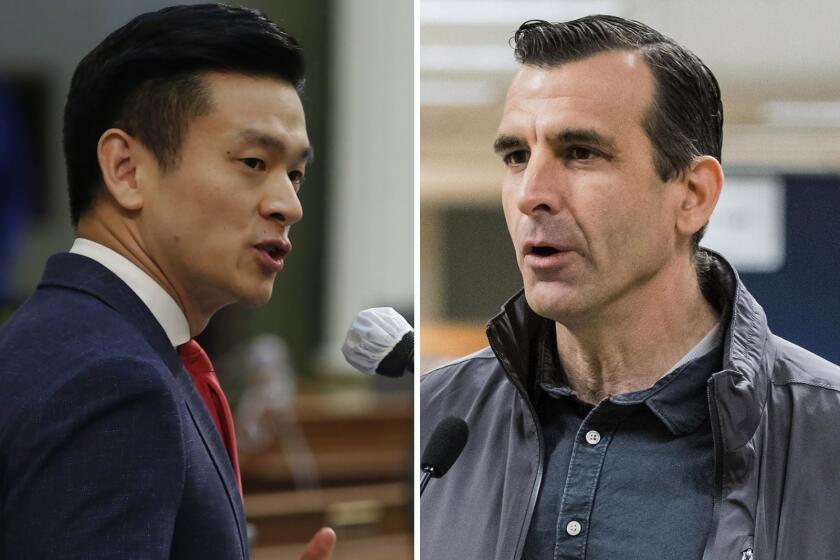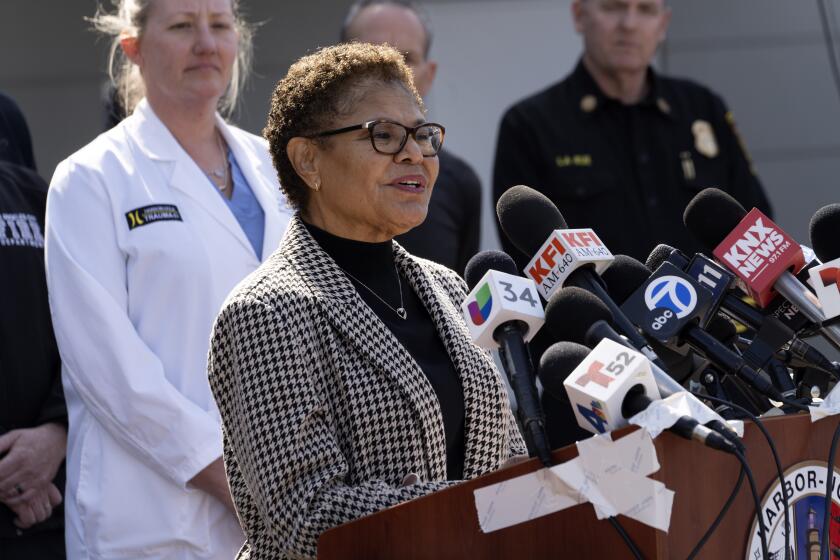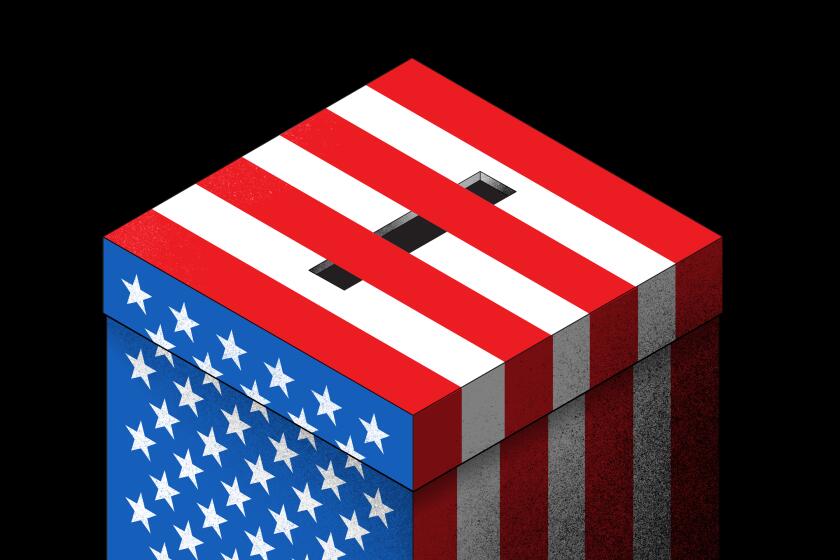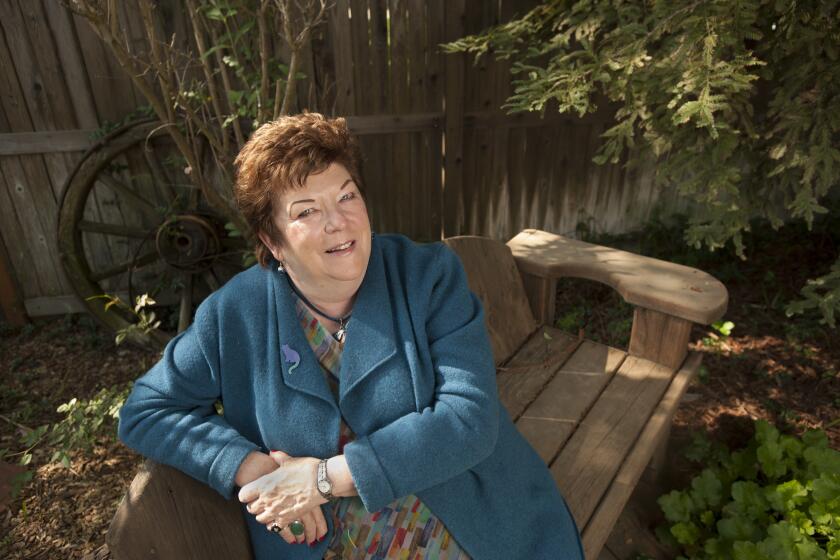Senate Remap Skips Some Regions : Reapportionment: Millions of Californians have no elected representative in the upper house while others have two. Situation will be corrected in 1994.
In a temporary case of political feast or famine, at least 4 million Californians are have no representation in the state Senate, while more than 8 million others have one senator too many.
Put another way, about one in seven residents has no elected voice in the upper chamber of the Legislature. But at the same time, almost one in three Californians enjoys two voices in the Senate and, at least theoretically, twice as much political clout.
For the next two years there probably will be some confusion when citizens try to contact their senators to speak their minds, seek help, file a complaint or lobby on a vote.
The oddity is a byproduct of the reapportionment of Senate districts carried out by the California Supreme Court early this year. All 40 districts were redrawn, but for the time being half the senators continue to serve their old areas.
The result: New lines crossing old lines put some senators into another’s territory for double coverage, while vast areas of California wound up without a senator.
Order will return and all Californians will have one senator again after the next general election in 1994. In the interim, the Senate Rules Committee, governing body of the Senate, is expected to appoint incumbents soon to provide constituent services for areas without an elected representative.
The complexity results from the staggered term setup peculiar to the California Senate. Half the members are elected from odd-numbered districts to four-year terms, all beginning in the same year. The other 20 senators are elected from even-numbered districts to four-year terms beginning two years later.
When reapportionment time rolls around, orderly representation goes temporarily out of whack. In the first election after reapportionment, half the senators abide by the newly drawn boundaries, while the other half--those in midterm at that point--do not occupy their new districts until election time two years later. In the meantime, they continue representing constituents in their old districts.
The process is challenging enough in the best of times. But no one seemed prepared for the massive dislocation created when the court took over the job of reshaping senatorial districts.
“The dimensions this time around are absolutely unprecedented,” said Tim Hodson, the Senate’s staff expert on reapportionment and chief consultant to the Elections Committee.
He estimated that when the Legislature performed its own reapportionment in the 1980s, about 601,000 residents were temporarily unrepresented in the Senate. And about 500,000 people were left out when districts were redrawn in the 1970s, he said.
Under this year’s state Supreme Court reapportionment, vast holes of the state are unrepresented, including six entire counties. Large areas of Los Angeles, Orange and San Diego counties and the Inland Empire are also without a senator.
Based on the 1990 Census, 474,513 residents in the cities of Los Angeles, Whittier, Norwalk, Santa Fe Springs, South Gate, Huntington Park, Bell and Cudahy are without an elected state senator. Statewide, nearly 4 million residents are unrepresented.
Many Californians may not know they have no elected state senator--and could care less if they did know. But some local officials and activists voice concern.
Mayor Robert Essertier of Hermosa Beach, whose city was represented before reapportionment by Sen. Robert G. Beverly (R-Long Beach), is caught in the void of having no Senate representation.
He said he intends to keep in close contact with newly elected Democratic Assemblywoman Debra Bowen on state issues but the Senate hole “leaves us with only half as many people working for us. . . . I just hope we don’t need anything out of Sacramento during the next two years.”
In the San Joaquin Valley, the Tulare County is without Senate representation. “We really lost out,” said Joy Sakai, a Visalia pharmacist and civic activist. “Who do you call? I don’t like that. But I feel that if I had a problem there are other (government officials) that I could go to.”
Also left stranded were the citizens of the northern counties of Trinity, Siskiyou, Sutter, Yolo and Tuolumne.
On the feast side of the equation, reapportionment consultant Hodson advised Californians with double representation in the Senate to “enjoy it.”
About 94,000 Malibu residents will be represented for two years by veteran Sen. Gary K. Hart (D-Santa Barbara) and new Sen. Tom Hayden (D-Santa Monica). “The good people of Malibu can write either to Gary Hart or Tom Hayden,” Hodson said.
Likewise, Democratic Sens. Diane Watson and Teresa Hughes, a former member of the Assembly, will jointly represent about 329,000 residents of Hawthorne, Inglewood, Lawndale, Lennox, the Westmont area and part of Los Angeles.
When it comes to selecting senators to provide services for districts without an elected representative, the Senate Rules Committee is expected to follow the practice of appointing members who probably will seek election from those areas in 1994.
In this way, incumbents would become familiar with their new constituents and vice versa. Arguably, a senator might pay special political attention to an area that could be key to reelection success or defeat.
Clifford Berg, executive officer of the Rules Committee, said that distributing the workload of unrepresented districts among incumbents would be based on the number of additional constituents, cost and willingness of the member to take on new territory.
With an eye toward the 1994 elections, Berg said, the Rules Committee will try to appoint incumbents who will provide unrepresented constituents with services at levels similar to those of areas with an elected senator.
Ingram reported from Sacramento, Rae-Dupree from Los Angeles.
More to Read
Get the L.A. Times Politics newsletter
Deeply reported insights into legislation, politics and policy from Sacramento, Washington and beyond. In your inbox three times per week.
You may occasionally receive promotional content from the Los Angeles Times.






